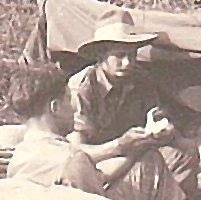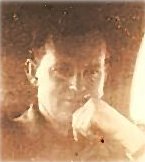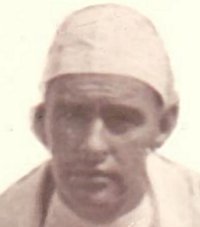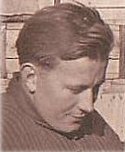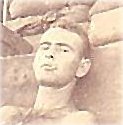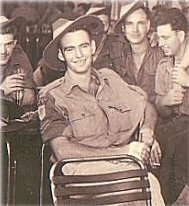| A Medic's Story: from the Medic of A Co 1 RAR John Frances (Doc) Thomas MM 2/4688 | 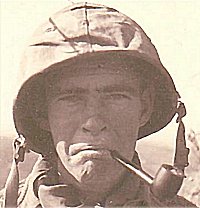 |
Introduction to Doc's story:
A story is the writer's version of his subject. It is unique. In the case of stories from a war, inevitably the unique version will not and cannot be comprehensive. There might appear to be inaccuracies. Variations between accounts of, for instance, Operation Blaze, will occur. Individual accounts will be from different unique points of view. The official accounts as in War Diaries or a commander's report can be expected to be as close to the "truth" as possible. Variations can be researched from whatever authoritative sources are available. Doc's story, is how he, the medic, viewed the battle. Thomson reported him "as being everywhere "on the battlefield, and of having "saved a lot of lives."
What happens in the heat of battle, I suggest, would leave memories seared in the mind, and they would be the memories that would be the truth for the person telling the story. It is I think of great value to learn of this individual experience, an experience like Doc Thomas' on 2nd July 1952. For his valiant care of the wounded that day he was awarded an immediate MM.
An authoritative account of Operation Blaze is covered on p243 in the Official History,"AUSTRALIA IN THE KOREAN WAR 1950 - 1953 VOLUME 2, OPERATION BLAZE, BY ROBERT O'NEILL, PUB BY AWM P. 243 Other authoritative accounts are those of the OC of A Co 1 RAR, Major David Thomson, and of Herb Stacker. Stacker's provides the citations of those who were given immediate awards for their valour.
| 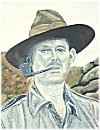 |
This selection of articles could provide an idea of the difficulty of attacking an enemy position in the static phase of the Korean War. As I was listening to Doc's story, in particular, a line from Siegfried Sassoon rang in my ears: "the hell where youth and laughter go."
In my conclusion, I will draw attention to the issues that this story raises; they could be checked from authoritative sources.
Doc's story has been carefully told to recapture the voice of a man telling his story from his memory of what happened over 50 years ago. I have tried to convey the way he was remembering. I believe there is great value in this.
Interview conducted by Olwyn Green 5/3/06
Doc : "It was a fiasco, the order was to capture a prisoner of war from Hill 227 - in daylight."
We had seen one earlier attempt to do that on Hill 227 and this was to be a repetition of that "massacre." One month earlier, the 1st Welch Battalion of 29th BCB was given the same order as we were given.
The Welch had to attack at night. At night Hill 227 was constantly lit by searchlights. When the attack was timed to begin, the plan was that there would first be a barrage of artillery. When the bombardment was lifted, the searchlights were to go out so that the attack could proceed in the dark.
But the searchlights did not go off and to worsen the situation the bombardment was not very effective because the Chinese were too deeply dug in. That meant the poor young Welch National Servicemen attacked and found themselves immediately exposed to accurate heavy fire. [Doc at this point told how the young soldiers, before the attack, were each given a ration C7 tin full of OP rum - implying that was not to their benefit.]
Doc "they were knocked off … " We , 4 - stretcher bearers and me - we went to the aid of the many wounded. Doc then explains that he the Cpl i/c of the CAP (Company Aid Post) was the only one allowed to carry morphia to treat the wounded. He had that night a container with 8 ampules of morphia.
Doc spoke of the incident that stuck in his mind when he and 4 stretcher bearers went to the aid of the wounded Welch servicemen.
He reached the first serious casualty who had had lost a leg
He got an ampule of morphia, injected it and mistakenly kept the container and threw away his 7 spare ampules of morphia. He had no morphia left.
The next casualty had lost half a shoulder. Fortunately he was an officer who had on him a container of morphia. He used one ampule and then had 7 spare ones, so he could go on treating the seriously wounded.
By chance his next patient was also an officer so that after he had treated him he had another 7 spare ampules, an abundance of morphia
"enough for a drug Lord" says Doc.
That important incident is always in Doc's mind when he thinks of 1 RAR's Operation Blaze, a similar operation to the Welch one, the one he called a "massacre". His description of the Australian attack is: "A fiasco"
The Australians were ordered to attack in DAYLIGHT. Doc thought that the reason for this was that control of the searchlight was not to be relied on. Another reason he offered (whether from memory or from his own thoughts) was that if the attack were in daylight it would cause surprise and find the Chinese asleep (patrolling of any kind was almost without exception done in the dark). The Official History gives another reason: that it would be easier to see what had to be done when the diggers got to their target - enemy trenches - from which they would capture a prisoner and blow up the trench.
{??? this assumed the attack would succeed).
OG to Doc " Did you know that several high ranking officers were on Hill 210, with binoculars, watching A company's attack? "Doc " We did not know then. We have heard it since."
At this point Doc's story is not in complete accord [sequentially or content-wise] with the account in the Official History but what he does remember is apparently accurate and significant. With the disastrous Welch attack still in his mind, he told how he warned the OC :
"Don't repeat what the Welch did giving the soldiers Rum"
[The reason was not given]
Each of the three platoons, in their respective positions trying to achieve their objectives, came under attack. Doc's memory focuses on HQ Co. The OC of A Company, David Thomson, with his HQ personnel, led the attack. ( At some point in the action he was wounded but declined to leave the battlefield.)
Doc's memory then flashed to Lt Gil Lucas of 1 Platoon who reached his target, a Chinese bunker, and fired a percussion bomb into the trench which sent at least one Chinese soldier scurrying. It was when a Chinese soldier hurtled out of the trench, says Doc, that they could have got a prisoner. But a digger covering Lucas with an Owen Gun, targeted the Chinese soldier.
So demanding was the sudden number of casualties in A Co that the Roman Catholic Padre, Padre Shine, MBE, assisted with the paper work to hasten the processing of the casualties to get them moved on to the appropriate hospital in Korea or Japan.
After about an hour or more of serious setbacks, this attack was called off by the C.O. and the men were ordered back to base, but only after the wounded had been carried to safety. Doc and Captain Peter Cook (2 i/c of A Co) [elsewhere it is recounted that his platoon was assisting in the evacuation of the wounded] found themselves the last on the hill. Their intention to get back via what they thought was a secret route was thwarted.
The Chinese already had their guns focused on the planned "secret" route and when he and Captain Cook looked down the hill they could see that the minefield route was being hit and mines were exploding. The shells were going over their heads so they had to remain where they were until the shelling ceased.
Captain Cook was concerned about the body of Private Gordon but Doc said to him that it would have to be left for "he could not be deader." When a lull occurred in the shelling, they were able to get back "through the wire."
DOC SUMMING UP: " 5 were killed and 25 were wounded. FOR WHAT?"
He repeated, "It was a fiasco" and with this repetition he spoke his mind aboutthe awards for that action. "It is the ones who died who should get the awards" - and he went on to mutter more about the awards in a sort of stream of consciousness way saying " they are allotted… it's just a procedure"
When he happened to mention that though most of his memories are of the terrible injuries, many funny things happened to him as a medic. He was asked to give an example; he related this incident.
A soldier who had served World War 2 "came to me in my hole." He was very "toey" about a domestic problem that caused him to impulsively join up for Korea. He explained the problem was "trouble with the wife" but offered the reason for his release and getting out of Korea not wife problems but that he was pissing the bed - he had become incontinent…..!!!!!
Doc "I'll see what I can do"
Doc approached the MO on soldier's behalf
MO What are the sleeping arrangements for this bloke?
Doc He is in a bunker with another bloke
[in a two-man bunker, one slept on the upper and one on the lower]
MO Which one is he in
Doc The upper one
MO Move him into the lower one.
That was how that application for discharge finished. No more was heard from the soldier. [Presumably he survived]
He tells how he was the second of 15 children. He found he got involved in "first aid" very early in that family situation. He left school at 13 years of age. He was working in the Railway in 1946 just after the war ended. Here he was trained to do First Aid He went to work at Concord Repatriation Hospital where he became an Operating Theatre technician. In 1951 when volunteers were still being sought for the Korean War, he joined up with the aim of becoming a medic. When he went to enlist he was asked what part of the service did he prefer e.g. infantry, engineers, etc.?
Doc I want to be a medic
He was told they had too many and he was put in the Engineers. Immediately he was put on a training course to qualify as a sapper. He became, temporarily, Sapper Jack Thomas, posted to the 1st Field Regiment at Casula. The Engineers had just returned from Woomera Rocket Range where they had been engaged in duties to do with the Rocket Range activities that the British were conducting (related to Atomic Bomb experimentation) As Doc wittily said "I was being trained to blow things up and then to fix them up."
| He was posted as Cpl i/c of the Convalescent Depot staffed by Japanese on Miya Jima, the famous small island off Japan that Doc jokingly likened to "Gillegan's Island." He remained there for 11 months. When it was learned he was due in Australia on a certain date to attend the investiture by Queen Elizabeth for the MM he had been awarded, leave was granted to him timed for him to attend the ceremony at Government House. Doc missed the ceremony. He explained: "All the chaps got their gongs off Lizzie but me. I was off courting a girl and missed it." Eventually he attended an investiture by the then Governor of Victoria, Sir Dallas Brooks. Back in Japan after his leave, and anxious to return home to his love, Doc soon got tired of his new posting at the British Commonwealth Hospital in an Operating Theatre. He grumbled "I hated working with the Poms so I applied to be returned home. | 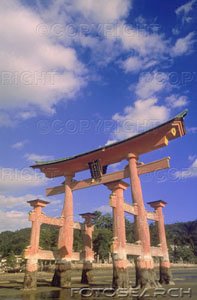 Miya Jima |
Back in Australia, he was sent to Puckapunyal where National Servicemen were being trained.
Doc Thomas realised when it came time to leave the army that he did not have a nursing certificate, so that he could only "end up doing the dirty jobs." This could seem trivial after what he did in Korea. He sums up the basics of his job of caring for the casualties, the trauma cases as: Stopping the bleeding and stopping the pain.
Once more a civilian, he fell back on his engineering training and got a job as a foreman in a foundry. He ended his working life back in First Aid, working for Colgates. He retired in 1984. He is Doc still to those he served with. His wife calls him John.OG . Asks questions about his service and the effects of the experience on him personally.
"I'm glad I was not an infantryman." About his health, he explained: As a result of 50 years of smoking I now have emphysema …and heart problems.
OG Do you have bad dreams?
John "No. I put all the horror of it out of my mind. I blank my mind. I know about all the blokes who have PTSD but no I don't have that.'
OG No bad memories at all John?
There is ONE he firmly says, and repeats:
I can't forget the smell of blood…….
Issues:
Generals Watching the Attack. The question is why did the Generals watch? All sorts of assumptions could be made. Did the officers know; did the troops know? The truth might lie in official documents
Medals/Awards . They are always an issue. Doc's concern was that it is those who sacrifice their lives who should be honoured. All will not agree with that. One cannot help asking if the generous issue of immediate awards this day had anything to do with the Generals watching.
Object of the Operation - to get a prisoner. The accepted reason for this "objective" is that prisoners of war could provide important information about the enemy. However, this has come under a lot of dispute. Again it would require a search of original sources to arrive at the real reason. Troops risked their lives to achieve this objective.
. Daylight Attack. In the Thomson paper available in this album, the reasons given for the daylight attack differ from those given in the Official History (see reference given above) and they agree with those given by Doc Thomas.
